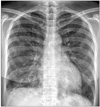Abstract
Immersion pulmonary edema (IPE) is a form of pulmonary edema that can occur in divers or swimmers. IPE is a rare condition, but can be life-threatening and recurrent condition. The pathophysiology of IPE is still incompletely understood. We present a case of scuba diving induced pulmonary edema in a 46-year-old woman diving in cold seawater. After 20 minutes of diving at 18 m, she felt difficulty of breathing. Symptoms on surfacing were dyspnea, cough, and frothy sputum. Chest X-ray showed pulmonary edema and she was treated with an intravenous diuretic and supplemental oxygen. The patient showed rapid resolution of symptoms and was discharged on the same day. Sport physician should be aware of this potentially life-threatening recurrent condition.
Figures and Tables
References
1. Edmonds C, Lippmann J, Lockley S, Wolfers D. Scuba divers' pulmonary oedema: recurrences and fatalities. Diving Hyperb Med. 2012; 42:40–44.
2. Cochard G, Arvieux J, Lacour JM, Madouas G, Mongredien H, Arvieux CC. Pulmonary edema in scuba divers: recurrence and fatal outcome. Undersea Hyperb Med. 2005; 32:39–44.
3. Grunig H, Nikolaidis PT, Moon RE, Knechtle B. Diagnosis of swimming induced pulmonary edema: a review. Front Physiol. 2017; 8:652.
4. Peacher DF, Martina SD, Otteni CE, Wester TE, Potter JF, Moon RE. Immersion pulmonary edema and comorbidities: case series and updated review. Med Sci Sports Exerc. 2015; 47:1128–1134.
5. Wilmshurst PT, Nuri M, Crowther A, Betts JC, Webb-Peploe MM. Forearm vascular responses in subjects who develop recurrent pulmonary edema when scuba-diving: a new syndrome. Br Heart J. 1981; 45:349.
6. Gnadinger CA, Colwell CB, Knaut AL. Scuba diving-induced pulmonary edema in a swimming pool. J Emerg Med. 2001; 21:419–421.
7. Adir Y, Shupak A, Gil A, et al. Swimming-induced pulmonary edema: clinical presentation and serial lung function. Chest. 2004; 126:394–399.
8. Wester TE, Cherry AD, Pollock NW, et al. Effects of head and body cooling on hemodynamics during immersed prone exercise at 1 ATA. J Appl Physiol (1985). 2009; 106:691–700.
9. Edmonds C. Drowning syndromes: the mechanism. SPUMS J. 1998; 28:2–9.
10. Moon RE, Martina SD, Peacher DF, et al. Swimming-induced pulmonary edema: pathophysiology and risk reduction with sildenafil. Circulation. 2016; 133:988–996.




 PDF
PDF ePub
ePub Citation
Citation Print
Print




 XML Download
XML Download